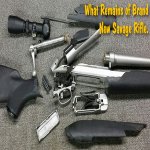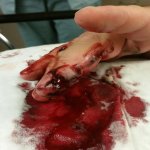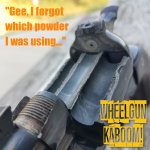Recycling and reworking other peoples reloads.
I'm sure that at one time or another, we've all had opportunities to buy somebody else’s reloads. You occasionally see these sold at gun shows where, for example, the seller may not know anything about that bunch of reloads – and may have just got the stuff from a friend or in a trade – or something like that.
Another example of the same type is a situation that has recently faced me. I had a chance to buy a whole bunch of reloads in 7.62X39 and 38 special, etc. from a gun shop – where the shop was selling the stuff on consignment. In that instance, the identity of the original reloader was known and he had had a long history of blowing up guns. This gentleman was selling his remaining stuff as he moved into a retirement home.
I'm sure some of the readers here who are kind of “that way” will be having a panic attack over the mere thought of buying this stuff. However, I did buy it at a good price – and haven't done anything with the lot so far.
A quick examination showed that the guy had left himself some notes sometimes specifying what powder he'd used and what his load was. Right off the bat, I found a small number of 7.62X39 reloads where the guy’s note – to himself – said that these were loaded with W680 and 85 gr. soft points and was clocked at over 3,100! Most of the rest of the X39 was 123 gr soft points – in seemingly conventional loadings (according to my cursory review – to-date).
These days primers are hard to get and even projectiles and powders are getting hard to obtain and/ or expensive. Accordingly, you can make a legitimate argument for taking these rounds apart and recycling some of the components. I'm sure that the super-safe way to do it is to disassemble each rounds with one of those RCBS bullet pullers, throw away the powder, decap the cases (which are all boxer primed) and save the remaining components (reloadable brass, primers and projectiles) for future use.
It seems a shame to throw away substantial amounts of recovered powders – especially where the ammo contains note saying what the powder is. Further, it is not terribly hard to establish the likelihood of what that powder is by matching its appearance to confirmed, known lots of, say AA1680 – and further verifying things by measuring powder density etc. However, as noted so far, I’m planning to dump the powders – even if everything says its, for example AA1680 – but others may have an opinion there.
I’ve also thought of lightening-up loads – for example taking loads apart and rethrowing the powder reducing each 38 Special round loading by some number of grains (compared to the other guy’s load). A variation on this variation would be to just pull the 158 or 180 grain projectiles – in the 38 Special reloads and replace these with lighter pills, say in the range of 110-125 grain pills – reusing that other guy’s existing powder load – so that one assumes you’d have an improved margin of safety. After that, I could do the testing – using a gun borrowed from someone else. I could do the same thing with the X39 reloads – say pulling the 123 gr projectiles and reseating 100-110s grain pills – just to err on the side of caution.
Some people might say just pull the X39 reloads apart and make them into “Mexican” (meaning “underpowered”) reloads – made by dumping the existing powder into a 303 British case – so that any possible overloading would be overcome.
What do you say?
I'm sure that at one time or another, we've all had opportunities to buy somebody else’s reloads. You occasionally see these sold at gun shows where, for example, the seller may not know anything about that bunch of reloads – and may have just got the stuff from a friend or in a trade – or something like that.
Another example of the same type is a situation that has recently faced me. I had a chance to buy a whole bunch of reloads in 7.62X39 and 38 special, etc. from a gun shop – where the shop was selling the stuff on consignment. In that instance, the identity of the original reloader was known and he had had a long history of blowing up guns. This gentleman was selling his remaining stuff as he moved into a retirement home.
I'm sure some of the readers here who are kind of “that way” will be having a panic attack over the mere thought of buying this stuff. However, I did buy it at a good price – and haven't done anything with the lot so far.
A quick examination showed that the guy had left himself some notes sometimes specifying what powder he'd used and what his load was. Right off the bat, I found a small number of 7.62X39 reloads where the guy’s note – to himself – said that these were loaded with W680 and 85 gr. soft points and was clocked at over 3,100! Most of the rest of the X39 was 123 gr soft points – in seemingly conventional loadings (according to my cursory review – to-date).
These days primers are hard to get and even projectiles and powders are getting hard to obtain and/ or expensive. Accordingly, you can make a legitimate argument for taking these rounds apart and recycling some of the components. I'm sure that the super-safe way to do it is to disassemble each rounds with one of those RCBS bullet pullers, throw away the powder, decap the cases (which are all boxer primed) and save the remaining components (reloadable brass, primers and projectiles) for future use.
It seems a shame to throw away substantial amounts of recovered powders – especially where the ammo contains note saying what the powder is. Further, it is not terribly hard to establish the likelihood of what that powder is by matching its appearance to confirmed, known lots of, say AA1680 – and further verifying things by measuring powder density etc. However, as noted so far, I’m planning to dump the powders – even if everything says its, for example AA1680 – but others may have an opinion there.
I’ve also thought of lightening-up loads – for example taking loads apart and rethrowing the powder reducing each 38 Special round loading by some number of grains (compared to the other guy’s load). A variation on this variation would be to just pull the 158 or 180 grain projectiles – in the 38 Special reloads and replace these with lighter pills, say in the range of 110-125 grain pills – reusing that other guy’s existing powder load – so that one assumes you’d have an improved margin of safety. After that, I could do the testing – using a gun borrowed from someone else. I could do the same thing with the X39 reloads – say pulling the 123 gr projectiles and reseating 100-110s grain pills – just to err on the side of caution.
Some people might say just pull the X39 reloads apart and make them into “Mexican” (meaning “underpowered”) reloads – made by dumping the existing powder into a 303 British case – so that any possible overloading would be overcome.
What do you say?












































































